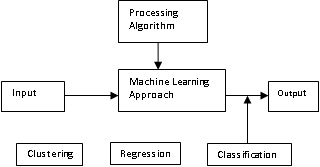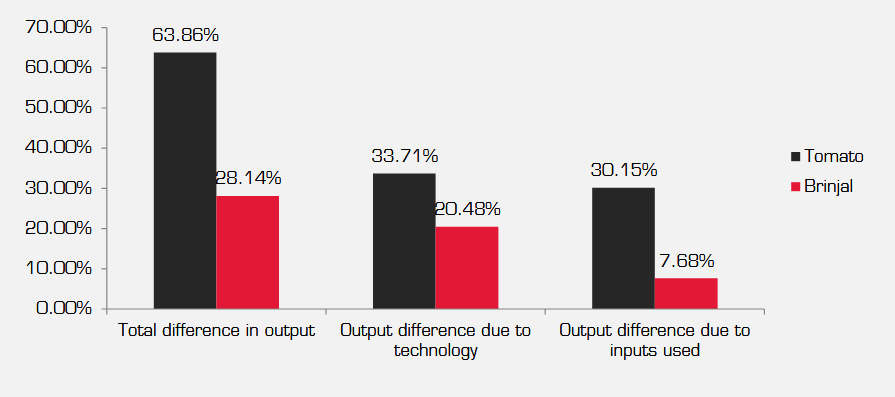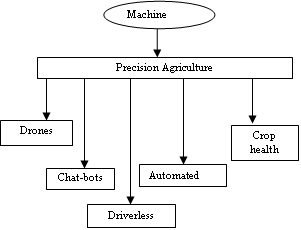pp. 37-44
1Victor Mokaya
Department of Computer science, School of Engineering & Technology
Suresh Gyan Vihar University Mahal road, Jagatpura
Jaipur, India
Mobile. 856390536
Abstract
Agriculture has been the backbone of India since time immemorial. With the ever changing weather and climate conditions, agricultural revolution in terms of crop cultivation, farming and animal breeding has also taken shape. Information and cognitive technologies have been the driving force behind the implementation of precision agriculture. In this paper promising solutions of precision agriculture which have been proven to work in other countries using machine learning & artificial intelligence are discussed. The wide scope of utilization for the present and future along with associated challenges have been examined with emphasis to medium and large scale commercial farmers. Advanced countries have already adopted these cognitive technologies which have resulted in increased output, growth in GDP, low mortality rates and improved living standards. Previously there has been a slow growth in this sector but from the year 2016 onwards many start ups have been emerging which are yielding high investments.
Keywords: precision agriculture, Artificial intelligence, Machine learning, promising solutions.
- Introduction
Agriculture in India is the major source of livelihood for almost two-thirds of the entire population. This sector has occupied approximately 43% of India’s geographical area. In the earlier days, India was largely dependent upon food imports but over the years through research, the country has achieved self-sufficiency in grain production. The country has made concerted efforts to be self-sufficient in the food production and this endeavor lead to the formation of the Green Revolution [1]. and enabled the country to achieve the following:
- Acquiring more land for cultivation.
- Expansion of irrigation schemes.
- Adoption of advanced high-yielding seeds.
- Application of better water management techniques.
- Plant protection activities through prudent use of fertilizers, pesticides and crop applications.
The above achievements in turn led to an impressive rise in wheat and rice production. Considering the quantum leap witnessed by the wheat and rice production, a national Pulse Development Programme that covered almost 13 states was set up in 1986 with the aim to introduce the improved technologies for farmers. A nationwide Technology task force was unveiled in 1986 after the success of National pulse Development Programme to improve the oil and seeds sector in India’s thrift. Pulses too came under this programme. This trend has continued till date and improvements have been witnessed continually. According to [2] Precision farming or precision agriculture refers to performing the right thing, in the right way, in the right place and at the right time. Management of crop production inputs such as water, soils, seed, fertilizer, etc to increase the yield quantity, profit, reduce waste, profit and becomes eco-friendly. Precision farming is meant to match agricultural practices as per agro-climatic conditions and crops to increase their respective applications accuracy. If you look at the Indian Agriculture, there are over 150 million hectares of farming land and more than 118 millions of farmers in India. In the last 40 years farming land has shrunk a little but the number of farmers had just doubled. As per Agricultural Census of 2010–11[3], the total number of operational holdings (individual farmers) was estimated as 138.35 million and the total operated area was 159.59 million hectare. The average size of holding had been estimated to be 1.15 hectare. It simply meant that one farmer was having 1.15 hectare of land to grow the crops. Out of these statistics Rajasthan was estimated as having 6888 million hectare number of operational holding and 21136 million hectare of total operated area. The average size of holding was estimated to be 3.07 hectare. This statistics meant that there is a huge scope to create a balance between the available lands versus the land under cultivation. To make this viable, precision agriculture offers an opportunity for Machine learning and Artificial intelligence to venture into this type of farming for its sustainability.
- Machine learning cognitive technology
According to [4] Machine Learning is the branch of artificial intelligence and computer science which deals with the creation of algorithms that exhibit self-learning property i.e. learning which is done by the machine itself hence the name “Machine Learning”. With the aid of machine learning accurate and efficient systems capable of evaluating a much wider set of tasks are developed to solve the day to day tasks. Scientists can use computer simulations to conduct early crop tests to evaluate how a certain variety may perform when faced with different sub climates, soil types, weather patterns and other factors. This digital testing does not replace physical field trials, but allows plant breeders to more accurately predict the performance of crops. The instance at which new variety germinates, machine learning has boosted breeders in creating more thoroughly vetted product than ever before.

Fig1. Machine learning data processing diagram
The information regarding the crop variety to be tested is used as input and passed through either supervised or unsupervised machine learning approach such as convolution neural network CNN, Bayesian network, support vector machine SVM etc. The approach analyses the input provided to extract the relevant features and information related to the problem subject. Based on the variables and conditions set, the processing algorithm performing the data analysis and provides a feasible output that is classified, clustered or regressed.
III. Impact of Precision Agriculture
Applying cognitive technologies in agriculture could aid in determining the best crop choice or the best hybrid seed choices for a crop adapted to varied objectives, conditions and better suited to farmers’ needs [5]. By analyzing and comparing information about seeds types, weather, types of soil, infestations in a certain area, probability of diseases and data about what worked best, year by year outcomes, current market trends, prices and consumer needs; farmers can make decisions on how yto maximize return on crops. The pace at which the machine learning technology is developing it would appear that the farming industry is on the cusp of a technological revolution under Artificial intelligence as its driving force.

Fig:2 Tomato and Brinjal productivity comparison using precision and imprecision farming.
- Machine learning technologies for precision farming
- Chat bots for farmers
Chat bots are conversational virtual assistant which automate interactions with end users. In agriculture chat bots are used for communication between farmers, government stakeholders, manufacturers and markets. While still in its early days chat bots were used mostly by retail, travel, media or insurance agencies. Agriculture could also leverage this emerging technology by assisting farmers with answers to their questions, giving advice and recommendations on specific farm problems [7]. The innovative mode will provide timely and interactive monitoring of the crops remotely.
- Drones and unmanned aerial vehicles
Unmanned aerial vehicles UAV are remote sensing autonomous vehicles that capture images and collect data about a particular scene. The use of UAV leads to low cost of operation and easy and wide environmental monitoring. These will be more widely accessible gadgets to come out of farming’s high tech makeover [8]. Providing new ways of increasing crop yields through in-depth analysis, long-distance crop spraying and high-efficiency crop analysis, technologies in drones is quickly gaining trust among farmers. Practical applications for drone technology are constantly advancing therefore it is likely that drone-powered solutions will be on the notch over the next few years.
iii. Driverless Tractors
Robotic agriculture is an anticipated future yet to be fully implemented in the next 10-15 years. Driverless tractors are independent tractors that perform all the farm practices autonomously. They are fixed with sensors that are able to perform the required practices, monitor obstacles and understand where to apply the farm inputs [9]. Driverless vehicle technology has been the adaptation across a wide array of technological firms. Agriculture is now combining off- shelf technologies such as GPS systems, radars and sensors. This sophistication in software and machinery are creating new avenues of enterprising farming and farmers will reduce pressures on an already strained workforce and allow for more acreage to be worked on for longer time periods.
- Automated irrigation systems
As farmers know, traditional irrigation management is an arduous task. Applying automated irrigation systems coupled with a heavy reliance on historical weather conditions will predict required resources. Thankfully automated irrigation systems are designed to utilize real time machine learning to constantly maintain desired soil conditions in order to increase average yields. Not only does this reduce the labor significantly but also provide the potential to drive down productions costs. Given that agriculture utilizes about 70% of the worlds freshwater, the ability to be conscious on how it’s managed would be a big impact on saving water towers and reservoirs
- Crop health monitoring
Traditional crop health monitoring techniques are extremely time consuming and mostly categorical. Companies in the race hyper spectral imaging and 3D laser scanning are predominantly increasing their precision and accuracy with the volume of data that gets collected.

Fig 3: Solutions to Precision agriculture
- Indian Agriculture and scope for Artificial intelligence
The sole driver and promotion of AI and its cognitive implications across industries, has not been just to reduce manual activities significantly, but progressively and accurately predict for future outcomes. Agriculture in the last decade has been limited by penetration of technology driven business, the onset of AI has allowed an opportunity to solve challenges like climate change and global warming. This milestone has helped to cope up with the increasing amount of complexity in modern farming. Farm Analytics driven by the cognitive ability of neural networks to run through large datasets, has become one of the high drive for efficiency and research driven applications.. While the development of AI algorithms can be a challenging task in an agricultural setting, the advent of big data and sector specific machine learning tools related to the sector can increase agriculture yields
The future of AI in farming is more important for a country like India, where more than 64% of the general population is still using direct agriculture while close to 75% still depends on the sector for their livelihood. Unlike the west, India’s agricultural problems cannot be dealt with just advanced agritech solutions like plant breeding and yield multiplication as farming still remains largely scattered and unorganized.
- Challenges of AI in Agricultural Sector in India
Although the use of AI is promising when it comes to farming, the development of AI algorithms can be challenging in agricultural setting. The initial and fundamental block requires large chunks of data, clean data to efficiently train the algorithms with significant amount of spatial data in agriculture. A greater amount of sufficient data is mostly available during the growing season which is once, making research cycles limited.
For India in particular, non-availability of data from remote areas and farmlands that don’t meet minimum hectare criteria during surveys are often left out, given the majority of our farmlands still remain fragmented, a mass dissertation or holistic data collection may be quite ambitious.
With the ever changing climatic conditions, there are unpredictable weather conditions in the soil texture. The unprecedented arrival of pests and diseases remains unknown even with enough protection measures in place. Farmers and growers may feel secured from all harvest and prepare for a bumper harvest but the uncertainties of nature are always in waiting
What may occur with the same seed and fertilizer in the United States may not be applicable in India. A few factors that could affect the variance would typically include the measurement of rain per unit of a crop planted, soil types, patterns of oil degradation, daylight hours, temperature and so forth. To address the problem of growers’ concerns; the problem is no two environments will be exactly alike, which makes the testing, validation and successful rollout of such technologies much more laborious than most other industries.
VII. Conclusion
It is possible to achieve the above vision in India in order to improve the food security and per capita income of the farmers. The above mentioned challenges and promising solutions are prediction of future landscape of the Indian agriculture. Technological advancements and government initiatives to foster and promote precision agriculture through aids, reliefs, tax holidays and other incentives to farmers will greatly attract investment. This move will thus help deliberate efforts to protect the growth and sustainability of future generations yet to come.
References
[1] Sebby, Kathryn, “The Green Revolution of the 1960’s and Its Impact on Small Farmers in India” (2010).Environmental Studies Undergraduate Student Theses. 10.http://digitalcommons.unl.edu/envstudtheses/10
[2]. https://www.ncpahindia.com/precision-farming
[3].http://www.agriculture.rajasthan.gov.in/content/dam/agriculture/Agriculture%20Department/agriculturalstatistics/statistics_at_a_glance/Vital_2016-17.pdf
[4]. Konstantinos G. Liakos1, Patrizia Busato 2, Dimitrios Moshou, Simon Pearson 4 and Dionysis Bochtis 1,* Machine Learning in Agriculture:A Review 2018 sensors journal.
[5]. Hakkim VM, Abdul & Joseph, Abhilash & Gokul AJ, Ajay & K, Mufeedha. (2016). Precision Farming: The Future of Indian Agriculture. Journal of Applied Biology and Biotechnology. 10.7324/JABB.2016.40609.
[7]. Agronomobot: A Smart Answering Chatbot Applied To Agricultural Sensor Networks Gustavo Marques Mostaço1, Ícaro Ramires Costa De Souza2, Leonardo Barreto Campos2, Carlos Eduardo Cugnasca1 A paper from the Proceedings of the 14th International Conference on Precision Agriculture June 24 – June 27, 2018 Montreal, Quebec, Canada
[8] Zhang, Chunhua & Kovacs, John. (2012). The application of small unmanned aerial systems for precision agriculture: A review. Precision Agriculture. 13. 10.1007/s11119-012-9274-5.
[9] Blackmore, B. S., Stout, W., Wang, M., and Runov, B. (2005).Robotic agriculture – the future of agricultural mechanisation? 5th European Conference on Precision Agriculture. ed. J. Stafford, V. The Netherlands, Wageningen Academic Publishers. pp.621-628.
